

A global archive of independent reviews of everything happening from the beginning of the millennium
Read our Copyright Notice click here
For publication dates click here
8 August 2020
Planning authorities
could hardly have expected a fulsome political defence when some of their
number were failing in their statutory duties in respect of the Planning Act
1990 as regards conservation areas.
Lèse majesté
when it comes to taking no notice of legitimate objections cuts two ways
with gatekeeping bureaucracies.
The first choice political response is to
get rid of them or curtail their reach drastically, with the civil service
executing the politicians' wishes.
Their only security lies in
thoughtfully following the statute. Miss out the law or the thought and they
are doomed.
On a visit to a Scandinavian capital that had found 40% of
its architects unemployed in a recession I was told that the only way a tall
building got built in the city was for a developer to half build it and
go bust, which would always happen, wait some time for the site to be bought by
someone else for very little and then completed a decade later.
Being a
developer is all about appearing bigger than you are as finances are often on a
knife edge.
When insolvency looks like being round the corner that is
the time to put in massive, unrealistic planning applications and when the
architects will end up never being paid.
To build these schemes would
bust the developers if that is not already their fate and everyone should
grumble less about unused planning permissions - a great many of them are for
horrific or unfinanceable schemes.
Conservation areas make some
sacrifices like not being able to install cost reducing solar panels on
roofs.
What
conservation areas cannot take is the recessionary Scandinavian scenario - bad
planning decisions contrary to the 1990 Act executed a decade later by quite
other people.
The planning industry's general defence - that 90% of planning
applications are approved anyway - condemns it out of its own
statement.
It
has moved away from providing a fair service to appearing to be a stooge or
frightened of those with potentially disappearing finances.
In the likely new scenario
where its day to day role will be the protection of certain areas, if a third
of planning applications are not rejected first time round, and half of those
in conservation areas, to improve them, people will want to know
why.
Architects would rather churn out a second, better scheme than
not be paid at all.
The economic cycle is what it is. Government can do much to
modify it but it will run its course.
*****
December 2020
What is the point of building
control if local authorities take building control fees without doing the job?
The evidence in the Grenfell enquiry is disturbing. Were the Building
Regulations really written so that they would not be enforced?
Local authorities have one
last chance to do their fee receiving functions properly and to serve the
public.
Otherwise, it will not be hard to push for the functions to be
taken away from them in the next legislative round. A precedent has been set in
the public health field.
June
2021
With
clear widespread failures of some local authorities to provide a service to the
public for which they receive fees, to enforce Building Regulations compliance
when they are acting in a building control capacity, to themselves comply with
the planning acts, to properly address rights of light legislation, to address
fire risks fully and to have suitably qualified staff, the government has since
moved to remove local authorities' planning authority role for buildings over
18 metres high.
Central government is likely to be more rigorous in hiring
suitably qualified staff and not cut corners for fees but the problems still
very much subsist for buildings under 18 metres high. This does not look like
the end of the road of scrutiny of what local authorities
do.
*****
December 2021
Institutions grow old and sometimes need to be put out of their misery, to start anew in order to completely change the governing ethos or the personnel.
Our planning legislation has for 70 years concentrated on protecting certain types of land from development rather than protecting people.
Ways of life sometimes need protecting but at times people are subjected to very rapid change even in a period, as now, when institutions are the better subjects for it.
Do not expect to come out of periods of plague, war or revolution without demise of institutions.
The post-war planning legislation was very understandable.
There was devasted land and bomb sites across the urban and industrial landscape and after wartime and post-war food rationing a need to maximise the availability of agricultural land to feed the nation.
Today we know that modern market gardening can be much more intensive in production and frequently more ecologically diverse than typical open field agriculture. This can be found in many a village adjacent to property, often to the older style cottage properties.
Mixed urban land use can be very productive. Vienna is dotted with vineyards. Newmarket is dotted with training stables.
However, adjacency often leads to classification as valuable development land whilst distant agricultural views are protected.
It is not, however, views that are most critical but quality of life concerns like having sufficient natural light and not bunching dwellings so close together that they shelter canyons of air pollution.
If a village is calling for conservation area status, grant it. If the planning authority pretends to maintain it but undermines it, call it out.
Otherwise, expect it to be swept away to central control or, better still, to new arrangements that give rein to assessment on quality of life and cultural issues.
If an incinerator is proposed by the coast with the prevailing wind out to sea - just possibly it could be permitted depending on the emissions cleaning. If it is in an urban area - a definite no. People are more important than distant views - but why is the incinerator proposed for town in the first place? Because that is the only place land can be found that is already zoned industrial?
More planning legislation continuing the current framework stokes anger about overcrowding. Allocation of development areas, with hidden toll-taking, is not the answer.
The U.K. population has fallen quite substantially in the past year and that is most noticeable in urban areas, even the most economically dynamic.
This gives a period of respite of some years but in that time we need to reassess.
*****
September 2024
Following the publication of the final report of the Grenfell inquiry, it is time to address the safety of future tall residential buildings in London.
Whenever a residential building suddenly catches fire, even of very modest height, and the reports are of very rapid spread of flame and of dense black smoke, the immediate surmise of seasoned professionals is that that will be down to plastic or foam based insulation (and not usually cladding) and hope to heaven that anyone within got out rapidly.
The fire report, however, will nearly always say that the cause was unknown. It would not have been worth a fire officer's job to tell it as it was - given the erstwhile power of the insulation lobby. That must change.
The government appears to be wanting to spread residential development around other cities rather than cram too much of it into London. Though that was not explicitly stated in the announcement, it is good idea.
So I am not entirely floating a kite now in advocating that new residential blocks in London be limited to about the height of London's first skyscraper, Adelaide House - let us say 45 metres.
The problem with Paris' boulevard planning was that every building ended up near the height limit but that was also influenced by how many flights of stairs one could ascend.
45 metres is high enough to not be the default for every residential development.
The higher you go, the more the structural costs escalate.
Grenfell shows that fire crews found it difficult to reach upper storeys up a single stairwell because of fear of running out of oxygen.
So 45 metres might be quite high enough but in all events tall buildings should have more than one very secure escape stairwell.
Given that 'stay put' advice really needs to phased out in most cases, personal evacuation plans are to be introduced for disabled people and fire stations are undermanned, 45 metres is quite enough.
PEOPLE NOT LAND
Reviewed by ANDRE BEAUMONT
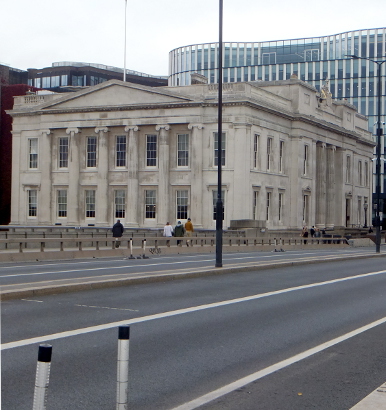
Fishmongers' Hall, London Bridge, November 2021
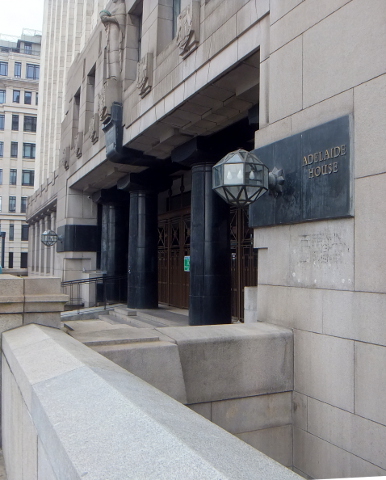
Adelaide House
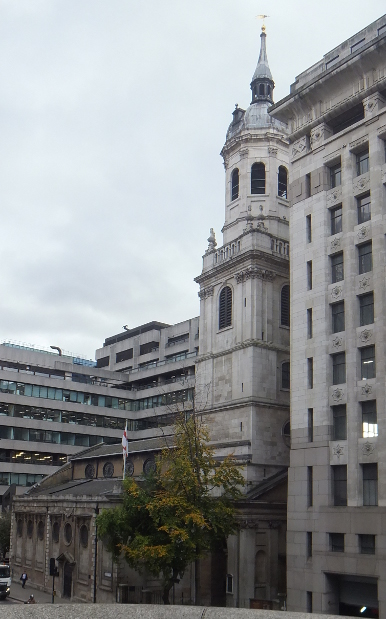
St Magnus-the-Martyr
It is a long time since I fought battles to save buildings, subsequently listed, against developers (Farringdon Station) or the Corporation of London (Smithfield Market) in the City or designed anything there but the listed and recently vacated Adelaide House is as important as its neighbours St Magnus-the-Martyr and Fishmongers' Hall in the history of design in the City.
Steel framed and at the same time Art Deco and modernist it was the first skyscraper at 141ft in Britain and stands at a turning point in building technology. It is improbable that the church did not extract a substantial sum from the first owner in its rights of light dispute over the new structure.
This is a financial district, which should have different rules, and where neighbours are well able to negotiate eight figure compensatory sums, but controversially I should like to see a height limit on new structures in London outside financial districts of about this height.
The residents of London benefit little from the taller structures. I once worked in one of the tallest buildings on the flightpath to Heathrow, where most are kept low, and it was horrible being in the only building looking into people's back gardens and swimming pools. Minus it and they would have had privacy.
We have done the tall buildings and there are enough to go round for anyone who wants to work or live in one. Let us now try something different. It could be reviewed again 30 years on. In the sixties we were on course to having elevated ring roads in the middle of London but stopped it all dead.
How high outside a financial district in London? The pictured structure is in a conservation area so no higher than what was there before which makes for a more liveable townscape. But were you to allow twice the height then the land value of the site might be 50% greater. That within limits might be okay but it inevitably pushes up the value of all plots and in a residential area that could mean gardens disappear and new build tends towards high rise flats that only really sell into foreign ownership.
Unlike New York or Paris the charm of London is that it is mainly low rise and not dominated by its road systems, skyscrapers or boulevards. I, too, like the really expensive finish and design experimentation in the City - a financial district - but it is kidding to assert that the same kind of resources are available for use across the rest of London.
London's first skyscraper at 141 feet high
So what height limit? 40 metres (131 ft), 50 metres (164 ft), 60 metres (194 ft).
In the medieval street patterns of the City it is thrilling to see older and shorter office buildings still nestling in beneath the skyscrapers. These towers that you may unexpectedly find yourself at the base of at the next turning, or after slipping down an alley, are great spectacle but, in the residential world, if they were leaving your previously agreeable home permanently in shadow, or backing onto your garden, then they would start to grate and leave you cheesed off.
Other question arise. Why is central government prescribing how many homes local authorities should allow to be built in an area? Why this micro-management? Government by target is so pre-coronavirus. So ancien régime. So fusty. Should it not set conservation-style limits - like the height limit and further protecting rights of light - and let the market manage the rest?
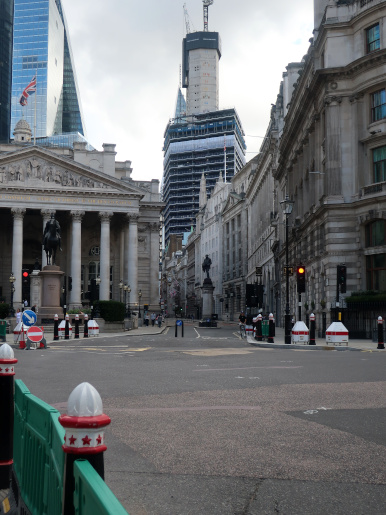
Spied from the Bank intersection the latest tower, One Leadenhall, going up
Should you have a professional advisor who tells you all you need to do is get planning permission they may not be very good (unlikely in the City). There may be rights of lights issues and they could be very expensive.
Generally, it is a good thing that neighbours have rights of light, and air rights, and subterranean rights.
St Mary Woolnoth obtained funds to build numerous suburban churches from selling its crypt for Bank Underground Station. So we repeated the trick the other way around at Aldgate.
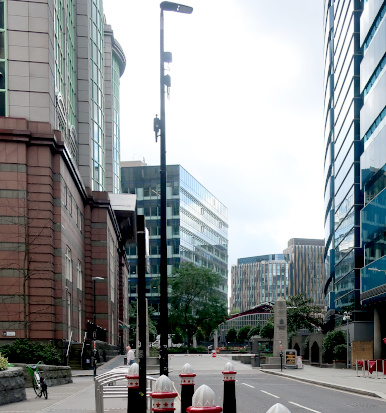
Aldgate Station from the rear - the platforms and tracks run below the plaza and road
Some stations are worth listing now because they never got much money for anything other than maintenance. Aldgate was one of four in the City that I had responsibility for. A river had once run to the side of where the tracks ran and the railway had bought the thin strip of land that included it for its original cut-and-cover. So we sold the air rights over it for the building with the rustication, on the left, to go up and the plaza in front of the building is directly above the end of the platforms.